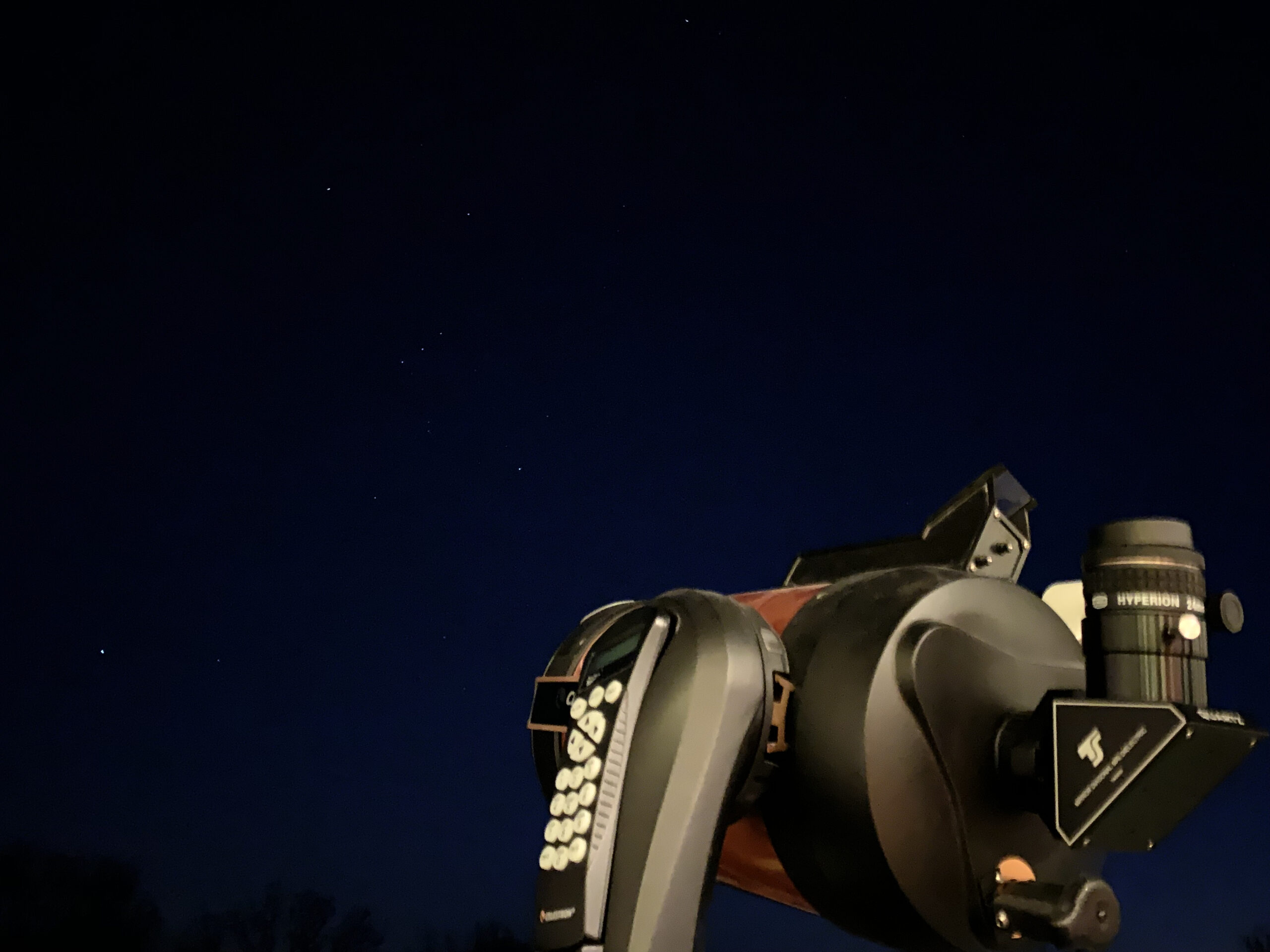Derzeit ist die ISS am abendlichen Himmel zu sehen. Führte ihre Bahn sehr nahe am Jupiter vorbei und endete beim Orion in Horizontnähe. Wobei ich nicht mehr sehen konnte, was die beiden hinter dem Baumgestrüpp so trieben. 😉
Tag: Internationale Raumstation
Auch heute ist ein sichtbarer Überflug der Internationalen Raumstation ISS angesagt. Er ist dieses Mal aber kürzer als sonst gewohnt. D.h. die Sonnenreflektion wird nur für den halben Weg vom Westen zum Osten für uns beobachtbar sein. Aber es reichte für den Durchflug durch den Orion. Aufname mit iPhone 11 Pro Max (3 Sekunden Belichtung … Read More “Die ISS versucht den Gürtel des Orion zu stehlen” »
Meine AllSky Kamera hat in den letzten Wochen überwiegend nur bewölkten Himmel aufgenommen. Ab und zu gibt es aber klare Momente, in denen der Himmel durchscheint. Am frühen Abend des 20. Januar habe ich mir die Livebilder angeschaut und dabei einen auffälligen Durchflug gesehen: Hier nochmal ein ein Einzelbild aus dem obigen Zeitraffer:
Heute ist der bundesweite Astronomietag. Leider fallen alle Veranstaltungen vor Ort wegen Corona / Covid-19 / SARS-CoV-2 aus. Aber viele Astronomievereinigungen, -freunde, Planetarien und Sternwarten bieten online Möglichkeiten, astronomische Themen oder den aktuellen Nachthimmel zu präsentieren. Ich schließe mich mal mit der heutigen markanten Konstellation am abendlichen Himmel an.
Nun, die wolkenfreien Tage müssen als Hobbyastronom ausgenutzt werden. In Zeiten von Corona / Covid-19 ist die heimische Beobachtung von der Balkonterrasse aus das Mittel der Wahl, natürlich nicht ohne Arbeitskleidung 😀 Die noch sehr schmale Mondsichel, aber auch die Venus waren schon vor dem offiziellen Sonnenuntergang am westlichen Himmel zu sehen:
Diesem Aufruf bin ich gerne gefolgt. Zumal ich diese Woche ja schon zwei ISS Überflüge dokumentiert habe: hier und hier. Und hier kommt nun meine Aufnahme der ISS als Strich am abendlichen Himmel: Die hohe ISO Zahl ist notwendig, damit die ISS bei dem noch aufgehellten Himmel gut erfasst wird. Dass ist mir vor zwei … Read More “#AlleBeobachtenDieISS: Dritte und vierte ISS-Beobachtung in dieser Woche am 25.03.20” »
Derzeit sind ja wolkenfreie Tage angesagt, was Astronomen mit und auch ohne Teleskop freut. Da diese Woche einige Konstellationen zu bewundern sind, fange ich einfach mal mit der ISS an, die derzeit am Abendhimmel über Deutschland sichtbar ist. Wer einen hellen Punkt am Himmel sieht, der nicht wie andere Sterne wabert, der nicht blinkt wie … Read More “Die ISS am Abendhimmel beim Stern Sirius” »
Front Page / Titelseite The first cookies baked in space are back on Earth! Following a ride home on a SpaceX Dragon capsule, the first food to be baked in space (a batch of cookies, of course) has landed back on Earth. read more … https://ift.tt/30iS6qi via Space.com https://ift.tt/2CqOJ61 A Mars sample-return mission is coming. … Read More “Weekly Spacecraft Mission News (English, German) – 16.01.2020” »
Front Page / Titelseite Rosetta ‘post-mission’ – new findings relating to the temperature and nature of the comet’s surface Two-and-a-half years have passed since the operational phase of the Rosetta mission came to an end in September 2016. However, scientific evaluation of the enormous amounts of data from the instruments on the spacecraft and the … Read More “Weekly Spacecraft Mission News (English, German) – 09.05.19” »
Front Page / Titelseite Power Issue on International Space Station / Problem bei der ISS-Stromversorgung Problem bei der ISS-Stromversorgung – Keine unmittelbare Gefahr für die Besatzung In der Internationalen Raumstation ISS ist es am Montag zu einem Problem bei der Stromversorgung gekommen. Es bestehe aber keine unmittelbare Gefahr für die Besatzung, teilte die US-Luft- und … Read More “Weekly Spacecraft Mission News (English, German) – 02.05.19” »
